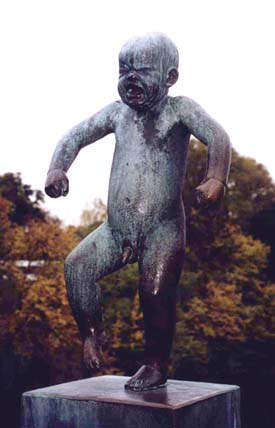 All of these
sculptures are from the Gustav
Vigelund Sculture Garden which is an 80 acre park in Oslo dedicated to
the sculptures of, you guessed it, Gustav Vigelund
(1869-1943). Vigelund did the architecture and the landscaping in the
park, and the sculptures, all 212 of them. Not one with a stitch of
clothing. The effect is not erotic though, but universal. The little guy
to the left is called "Sinnataggen", the little hot head, and caused quite
a stir when he was stolen in 1992.
All of these
sculptures are from the Gustav
Vigelund Sculture Garden which is an 80 acre park in Oslo dedicated to
the sculptures of, you guessed it, Gustav Vigelund
(1869-1943). Vigelund did the architecture and the landscaping in the
park, and the sculptures, all 212 of them. Not one with a stitch of
clothing. The effect is not erotic though, but universal. The little guy
to the left is called "Sinnataggen", the little hot head, and caused quite
a stir when he was stolen in 1992.
The parkland and a studio were made available to the artist by the
City of Oslo under an agreement made in 1921. In exchange he signed
ownership of all of his sculptures drawings and woodcuts, as well as the
ownership of all future works, over to the city. He moved into the studio
in 1924 and lived there until his death in 1943, when the studio was
turned into a museum. While all of the sculpture in the park was
originally modelled by Vigeland, the actual carving in granite was done by
professional artisans from full size models made by him.
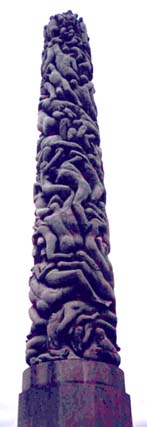 The
Monolith is a 46 foot high column carved from a single block of stone, and
contains 121 figures. Vigeland took only ten months to complete the model
of the monolith in 1924 and 1925, but the granite version took three stone
carvers from 1929 to 1943 to complete. Many interpretations of the
monolith have been suggested, but Vigeland stated that he had no wish to
express an opinion about the "meaning" of the Monolith, but said "The
stone groups tell about life, the column about the world of fantasy. The
stone groups can therefore be understood by anyone, each can interpret the
column in his own way". Your guess is good as mine. This is probably the
single Vigeland work that shows up the most on the web, but why should I
be different?
The
Monolith is a 46 foot high column carved from a single block of stone, and
contains 121 figures. Vigeland took only ten months to complete the model
of the monolith in 1924 and 1925, but the granite version took three stone
carvers from 1929 to 1943 to complete. Many interpretations of the
monolith have been suggested, but Vigeland stated that he had no wish to
express an opinion about the "meaning" of the Monolith, but said "The
stone groups tell about life, the column about the world of fantasy. The
stone groups can therefore be understood by anyone, each can interpret the
column in his own way". Your guess is good as mine. This is probably the
single Vigeland work that shows up the most on the web, but why should I
be different?
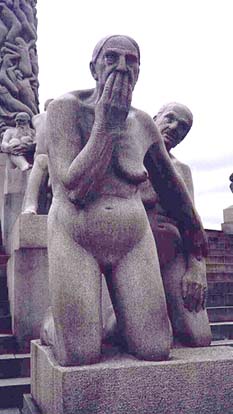 Around
the monolith are a collection of statues in granite that include some of
the most intense sculpture in the park. The sculptures in this area were
started around the time of the first world war and completed in 1936.
There are 36 groupings of statues, all dealing with the various periods in
the cycle of life--birth, childhood, adolescence, maturity, old age, and
death, with people portrayed in "a variety of typical human situations and
relationships." Or that is what the museum site says, though you can
decide for yourself how typical they are.
Around
the monolith are a collection of statues in granite that include some of
the most intense sculpture in the park. The sculptures in this area were
started around the time of the first world war and completed in 1936.
There are 36 groupings of statues, all dealing with the various periods in
the cycle of life--birth, childhood, adolescence, maturity, old age, and
death, with people portrayed in "a variety of typical human situations and
relationships." Or that is what the museum site says, though you can
decide for yourself how typical they are.
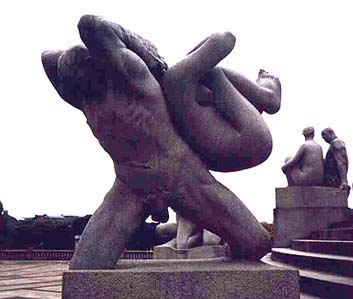
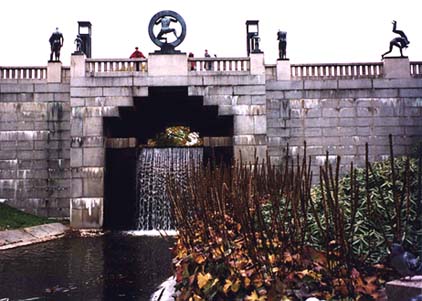 The
bridge is 100 meters long and 15 meters wide and is built on top of an old
bridge constructed in 1914. Vigeland designed the new bridge and modelled
the 58 bronze sculptures in the years 1925 to 1933. The sculptures stand
on either side of the Bridge, and portray people of widely differing ages,
although there is less emphasis on old age than in other areas in the
park.
The
bridge is 100 meters long and 15 meters wide and is built on top of an old
bridge constructed in 1914. Vigeland designed the new bridge and modelled
the 58 bronze sculptures in the years 1925 to 1933. The sculptures stand
on either side of the Bridge, and portray people of widely differing ages,
although there is less emphasis on old age than in other areas in the
park.
 All of these
sculptures are from the Gustav
Vigelund Sculture Garden which is an 80 acre park in Oslo dedicated to
the sculptures of, you guessed it, Gustav Vigelund
(1869-1943). Vigelund did the architecture and the landscaping in the
park, and the sculptures, all 212 of them. Not one with a stitch of
clothing. The effect is not erotic though, but universal. The little guy
to the left is called "Sinnataggen", the little hot head, and caused quite
a stir when he was stolen in 1992.
All of these
sculptures are from the Gustav
Vigelund Sculture Garden which is an 80 acre park in Oslo dedicated to
the sculptures of, you guessed it, Gustav Vigelund
(1869-1943). Vigelund did the architecture and the landscaping in the
park, and the sculptures, all 212 of them. Not one with a stitch of
clothing. The effect is not erotic though, but universal. The little guy
to the left is called "Sinnataggen", the little hot head, and caused quite
a stir when he was stolen in 1992. The
Monolith is a 46 foot high column carved from a single block of stone, and
contains 121 figures. Vigeland took only ten months to complete the model
of the monolith in 1924 and 1925, but the granite version took three stone
carvers from 1929 to 1943 to complete. Many interpretations of the
monolith have been suggested, but Vigeland stated that he had no wish to
express an opinion about the "meaning" of the Monolith, but said "The
stone groups tell about life, the column about the world of fantasy. The
stone groups can therefore be understood by anyone, each can interpret the
column in his own way". Your guess is good as mine. This is probably the
single Vigeland work that shows up the most on the web, but why should I
be different?
The
Monolith is a 46 foot high column carved from a single block of stone, and
contains 121 figures. Vigeland took only ten months to complete the model
of the monolith in 1924 and 1925, but the granite version took three stone
carvers from 1929 to 1943 to complete. Many interpretations of the
monolith have been suggested, but Vigeland stated that he had no wish to
express an opinion about the "meaning" of the Monolith, but said "The
stone groups tell about life, the column about the world of fantasy. The
stone groups can therefore be understood by anyone, each can interpret the
column in his own way". Your guess is good as mine. This is probably the
single Vigeland work that shows up the most on the web, but why should I
be different? Around
the monolith are a collection of statues in granite that include some of
the most intense sculpture in the park. The sculptures in this area were
started around the time of the first world war and completed in 1936.
There are 36 groupings of statues, all dealing with the various periods in
the cycle of life--birth, childhood, adolescence, maturity, old age, and
death, with people portrayed in "a variety of typical human situations and
relationships." Or that is what the museum site says, though you can
decide for yourself how typical they are.
Around
the monolith are a collection of statues in granite that include some of
the most intense sculpture in the park. The sculptures in this area were
started around the time of the first world war and completed in 1936.
There are 36 groupings of statues, all dealing with the various periods in
the cycle of life--birth, childhood, adolescence, maturity, old age, and
death, with people portrayed in "a variety of typical human situations and
relationships." Or that is what the museum site says, though you can
decide for yourself how typical they are.
 The
bridge is 100 meters long and 15 meters wide and is built on top of an old
bridge constructed in 1914. Vigeland designed the new bridge and modelled
the 58 bronze sculptures in the years 1925 to 1933. The sculptures stand
on either side of the Bridge, and portray people of widely differing ages,
although there is less emphasis on old age than in other areas in the
park.
The
bridge is 100 meters long and 15 meters wide and is built on top of an old
bridge constructed in 1914. Vigeland designed the new bridge and modelled
the 58 bronze sculptures in the years 1925 to 1933. The sculptures stand
on either side of the Bridge, and portray people of widely differing ages,
although there is less emphasis on old age than in other areas in the
park.